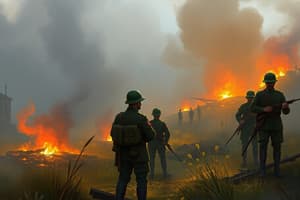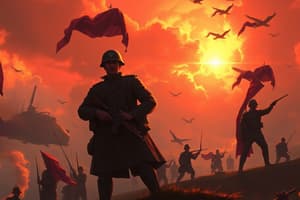Podcast
Questions and Answers
What was the immediate trigger that led to the outbreak of World War I?
What was the immediate trigger that led to the outbreak of World War I?
- The sinking of the Lusitania
- The assassination of Archduke Franz Ferdinand (correct)
- The signing of the Treaty of Versailles
- The invasion of Belgium
Which major powers formed alliances that contributed to the escalation of World War I?
Which major powers formed alliances that contributed to the escalation of World War I?
- Germany and France
- Russia and the United States
- Germany and Austria-Hungary (correct)
- Austria-Hungary and Italy
What military tactic became prominent during World War I, characterized by soldiers in extensive defensive positions?
What military tactic became prominent during World War I, characterized by soldiers in extensive defensive positions?
- Naval blockades
- Trench warfare (correct)
- Aerial dogfights
- Guerrilla warfare
What significant social change occurred as a result of World War I?
What significant social change occurred as a result of World War I?
What was one of the major outcomes of the Treaty of Versailles signed in 1919?
What was one of the major outcomes of the Treaty of Versailles signed in 1919?
Flashcards are hidden until you start studying
Study Notes
Overview of World War I
- World War I, known as the Great War, lasted from 1914 to 1918 and was one of history's deadliest conflicts.
- The war fundamentally altered the political landscape of Europe and beyond.
Causes of the War
- Root causes included complex alliances, militarism, nationalism, and imperial rivalries.
- The assassination of Archduke Franz Ferdinand of Austria-Hungary on June 28, 1914, acted as the immediate catalyst.
- The assassination was carried out by a Serbian nationalist, triggering a chain reaction among European powers.
Outbreak of Conflict
- Austria-Hungary, supported by Germany, issued an ultimatum to Serbia, leading to war declaration on July 28, 1914.
- Russia mobilized to defend Serbia, prompting Germany to declare war on Russia.
- France and Britain, due to alliance commitments, entered the war, expanding the conflict into a full-scale war.
Warfare and Innovations
- The war was marked by trench warfare, resulting in harsh conditions on the Western Front.
- Significant battles, such as the Somme and Verdun, resulted in enormous casualty numbers.
- New technologies like tanks, airplanes, and chemical weapons revolutionized combat and increased lethality.
Global Involvement
- The conflict was not limited to Europe; it involved nations worldwide, including the United States, which joined the war in 1917.
Social Changes
- The war prompted significant social transformations, particularly in gender roles, as women entered the workforce in unprecedented numbers.
Conclusion and Aftermath
- The war concluded with the signing of the Armistice on November 11, 1918.
- The Treaty of Versailles, signed in 1919, imposed heavy reparations on Germany and redrew national borders.
- The redrawing of borders created new countries and laid the groundwork for future global conflicts, including World War II.
- The legacy of World War I continues to shape global politics and international relations today.
Studying That Suits You
Use AI to generate personalized quizzes and flashcards to suit your learning preferences.




